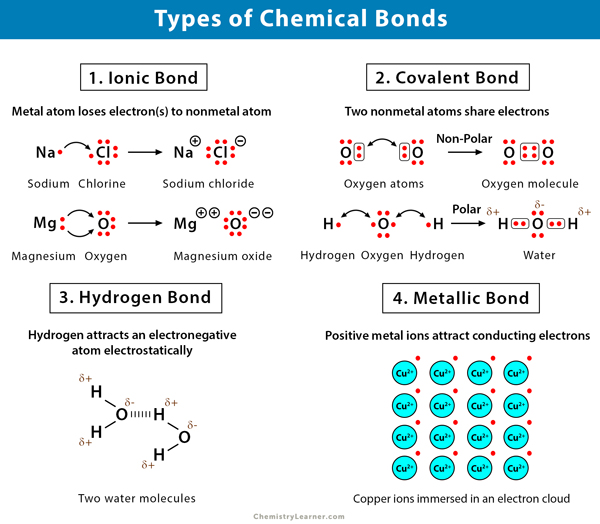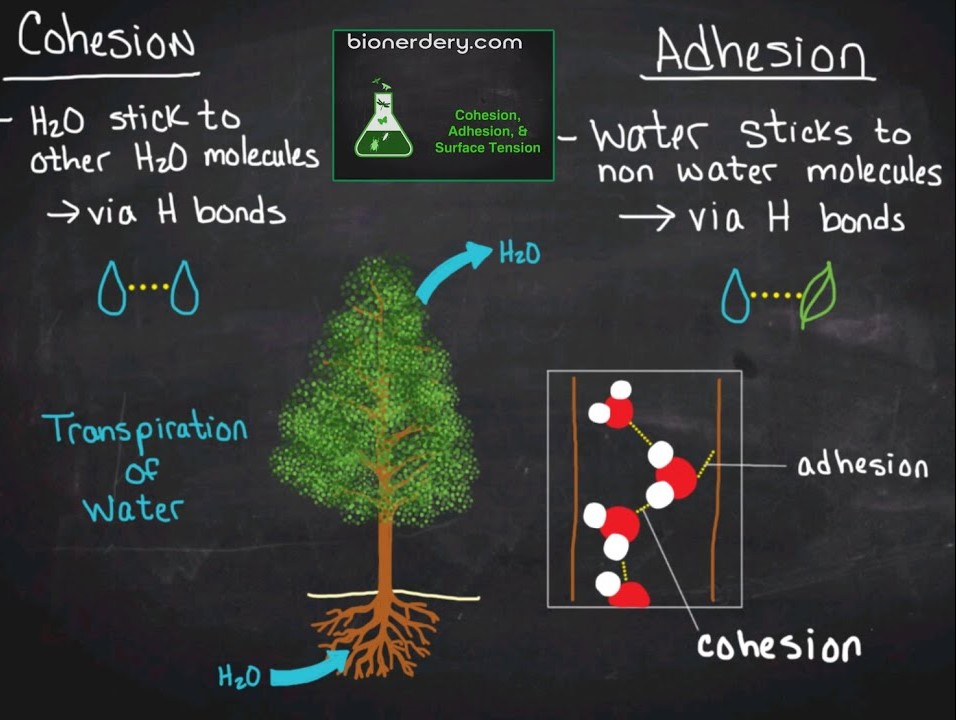Atoms, Molecules, and Bonds
Atoms consist of a nucleus that contains positively charged protons and neutrally charged neutrons. Electrons, which are negatively charged, orbit the nucleus of the cell.
A molecule is a group of 2 or more atoms that are held together by chemical bonds. The electronegativity of the atom is the ability of the atom to attract and keep electrons, and in many cases, it determines what type of bond will be formed. There are 3 types of bonds:
- Ionic bonds are bonds between two atoms where electrons are transferred between them. This can only occur when the two atoms have very different electronegativities (so that one atom has a much stronger attraction for electrons). The high electronegativity atom will pull electrons away from the low electronegativity atom, causing electrons to be transferred. An example of an ionic bond is sodium chloride (NaCl).
- Covalent bonds have two subtypes. Unlike ionic bonds, covalent bonds occur when two atoms share their electrons (so that neither atom has full control over the electrons). Covalent bonds can only occur when the two atoms have similar electronegativities.
- Nonpolar covalent bonds are bonds in which the electrons are shared equally. The two atoms that share electrons may be identical, such as oxygen gas (O2).
- Polar covalent bonds are bonds in which the two atoms share electrons unequally. Since the electrons are unequally distributed through the molecule, one of the poles of the molecule will have a charge. Water (H2O) is a polar covalent molecule.
- Single covalent bonds are bonds in which two electrons are shared. Double covalent bonds are bonds in which four electrons are shared, and triple covalent bonds are bonds in which 6 electrons are shared.
- Hydrogen bonds are weak bonds that only occur between molecules. Hydrogen atoms in one covalently bonded molecule is attracted to an area of negative charge of another covalently bonded molecule.

Water Properties
Many of the properties of water rely on its hydrogen bonds and polarity.
Water is a good solvent. This means tha many different compounds can dissolve in water. Ionic substances are soluble because the different poles of the water molecules split the ionic substances into different ions. Hydrophilic substances easily dissolve in water, while hydrophobic substances such as oil do not. Solutes are any substances that dissolve in a solution, and when the solvent is water, the solution is called an aqueous solution.
Water also has a high specific heat capacity. Specific heat is the amount of heat energy required to raise the substance's temperature by 1 degree. Water has a high specific heat, meaning it can absorb a lot of heat energy before evaporating. This is one of the reasons why we sweat. The water we sweat absorbs the heat energy in our skin and then evaporates, cooling us.
Heat of fusion is the amount of energy needed to change water from a solid to a liquid and heat of vaporization is the amount of energy required to turn water from a liquid to a gas.
Unlike many other substances, water in its solid form is less dense than water in its liquid form. This is because as water freezes, it expands. When water freezes, the hydrogen bonds stiffen and become rigid, pushing water molecules farther away from each other, and therefore making the solid form less dense.
Water also has a strong cohesion and high surface tension. Cohesion is the ability of substances of the same type to stick together. In this case, it is the tendency of water molecules to stick together. Since water has a high surface tension, some insects are able to walk on water.
Water also has strong adhesion. Adhesion is the ability of one substance to stick to another substance. For water, it is the ability of water molecules to stick to molecules in other objects. This is displayed by capillary action, which is the tendency of water to rise up the walls of narrow tubing or move through paper.

Organic Molecules
Organic molecules are molecules that contain carbon atoms. Large organic molecules are called macromolecules. Many macromolecules are polymers, which are combinations of the same smaller unit called a monomer.
Organic molecules consists of the same few functional groups, which are similar clusters of atoms.

